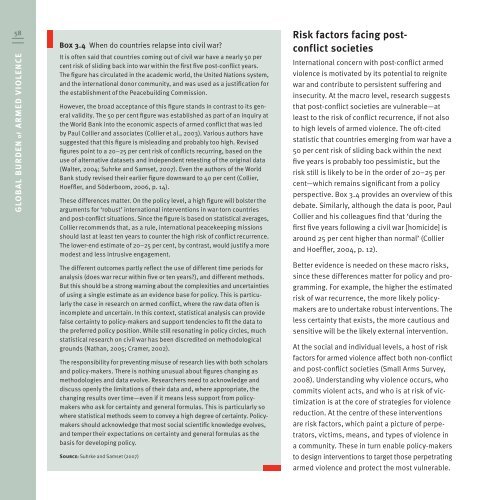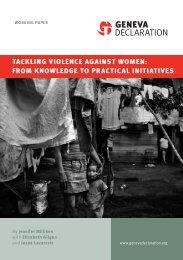Global Burden of Armed Violence - The Geneva Declaration on ...
Global Burden of Armed Violence - The Geneva Declaration on ...
Global Burden of Armed Violence - The Geneva Declaration on ...
You also want an ePaper? Increase the reach of your titles
YUMPU automatically turns print PDFs into web optimized ePapers that Google loves.
58<br />
GLOBAL BURDEN <str<strong>on</strong>g>of</str<strong>on</strong>g> ARMED VIOLENCE<br />
Box 3.4 When do countries relapse into civil war?<br />
It is <str<strong>on</strong>g>of</str<strong>on</strong>g>ten said that countries coming out <str<strong>on</strong>g>of</str<strong>on</strong>g> civil war have a nearly 50 per<br />
cent risk <str<strong>on</strong>g>of</str<strong>on</strong>g> sliding back into war within the first five post-c<strong>on</strong>flict years.<br />
<str<strong>on</strong>g>The</str<strong>on</strong>g> figure has circulated in the academic world, the United Nati<strong>on</strong>s system,<br />
and the internati<strong>on</strong>al d<strong>on</strong>or community, and was used as a justificati<strong>on</strong> for<br />
the establishment <str<strong>on</strong>g>of</str<strong>on</strong>g> the Peacebuilding Commissi<strong>on</strong>.<br />
However, the broad acceptance <str<strong>on</strong>g>of</str<strong>on</strong>g> this figure stands in c<strong>on</strong>trast to its general<br />
validity. <str<strong>on</strong>g>The</str<strong>on</strong>g> 50 per cent figure was established as part <str<strong>on</strong>g>of</str<strong>on</strong>g> an inquiry at<br />
the World Bank into the ec<strong>on</strong>omic aspects <str<strong>on</strong>g>of</str<strong>on</strong>g> armed c<strong>on</strong>flict that was led<br />
by Paul Collier and associates (Collier et al., 2003). Various authors have<br />
suggested that this figure is misleading and probably too high. Revised<br />
figures point to a 20–25 per cent risk <str<strong>on</strong>g>of</str<strong>on</strong>g> c<strong>on</strong>flicts recurring, based <strong>on</strong> the<br />
use <str<strong>on</strong>g>of</str<strong>on</strong>g> alternative datasets and independent retesting <str<strong>on</strong>g>of</str<strong>on</strong>g> the original data<br />
(Walter, 2004; Suhrke and Samset, 2007). Even the authors <str<strong>on</strong>g>of</str<strong>on</strong>g> the World<br />
Bank study revised their earlier figure downward to 40 per cent (Collier,<br />
Hoeffler, and Söderboom, 2006, p. 14).<br />
<str<strong>on</strong>g>The</str<strong>on</strong>g>se differences matter. On the policy level, a high figure will bolster the<br />
arguments for ‘robust’ internati<strong>on</strong>al interventi<strong>on</strong>s in war-torn countries<br />
and post-c<strong>on</strong>flict situati<strong>on</strong>s. Since the figure is based <strong>on</strong> statistical averages,<br />
Collier recommends that, as a rule, internati<strong>on</strong>al peacekeeping missi<strong>on</strong>s<br />
should last at least ten years to counter the high risk <str<strong>on</strong>g>of</str<strong>on</strong>g> c<strong>on</strong>flict recurrence.<br />
<str<strong>on</strong>g>The</str<strong>on</strong>g> lower-end estimate <str<strong>on</strong>g>of</str<strong>on</strong>g> 20–25 per cent, by c<strong>on</strong>trast, would justify a more<br />
modest and less intrusive engagement.<br />
<str<strong>on</strong>g>The</str<strong>on</strong>g> different outcomes partly reflect the use <str<strong>on</strong>g>of</str<strong>on</strong>g> different time periods for<br />
analysis (does war recur within five or ten years?), and different methods.<br />
But this should be a str<strong>on</strong>g warning about the complexities and uncertainties<br />
<str<strong>on</strong>g>of</str<strong>on</strong>g> using a single estimate as an evidence base for policy. This is particularly<br />
the case in research <strong>on</strong> armed c<strong>on</strong>flict, where the raw data <str<strong>on</strong>g>of</str<strong>on</strong>g>ten is<br />
incomplete and uncertain. In this c<strong>on</strong>text, statistical analysis can provide<br />
false certainty to policy-makers and support tendencies to fit the data to<br />
the preferred policy positi<strong>on</strong>. While still res<strong>on</strong>ating in policy circles, much<br />
statistical research <strong>on</strong> civil war has been discredited <strong>on</strong> methodological<br />
grounds (Nathan, 2005; Cramer, 2002).<br />
<str<strong>on</strong>g>The</str<strong>on</strong>g> resp<strong>on</strong>sibility for preventing misuse <str<strong>on</strong>g>of</str<strong>on</strong>g> research lies with both scholars<br />
and policy-makers. <str<strong>on</strong>g>The</str<strong>on</strong>g>re is nothing unusual about figures changing as<br />
methodologies and data evolve. Researchers need to acknowledge and<br />
discuss openly the limitati<strong>on</strong>s <str<strong>on</strong>g>of</str<strong>on</strong>g> their data and, where appropriate, the<br />
changing results over time—even if it means less support from policymakers<br />
who ask for certainty and general formulas. This is particularly so<br />
where statistical methods seem to c<strong>on</strong>vey a high degree <str<strong>on</strong>g>of</str<strong>on</strong>g> certainty. Policymakers<br />
should acknowledge that most social scientific knowledge evolves,<br />
and temper their expectati<strong>on</strong>s <strong>on</strong> certainty and general formulas as the<br />
basis for developing policy.<br />
Source: Suhrke and Samset (2007)<br />
Risk factors facing post-<br />
c<strong>on</strong>flict societies<br />
Internati<strong>on</strong>al c<strong>on</strong>cern with post-c<strong>on</strong>flict armed<br />
violence is motivated by its potential to reignite<br />
war and c<strong>on</strong>tribute to persistent suffering and<br />
insecurity. At the macro level, research suggests<br />
that post-c<strong>on</strong>flict societies are vulnerable—at<br />
least to the risk <str<strong>on</strong>g>of</str<strong>on</strong>g> c<strong>on</strong>flict recurrence, if not also<br />
to high levels <str<strong>on</strong>g>of</str<strong>on</strong>g> armed violence. <str<strong>on</strong>g>The</str<strong>on</strong>g> <str<strong>on</strong>g>of</str<strong>on</strong>g>t-cited<br />
statistic that countries emerging from war have a<br />
50 per cent risk <str<strong>on</strong>g>of</str<strong>on</strong>g> sliding back within the next<br />
five years is probably too pessimistic, but the<br />
risk still is likely to be in the order <str<strong>on</strong>g>of</str<strong>on</strong>g> 20–25 per<br />
cent—which remains significant from a policy<br />
perspective. Box 3.4 provides an overview <str<strong>on</strong>g>of</str<strong>on</strong>g> this<br />
debate. Similarly, although the data is poor, Paul<br />
Collier and his colleagues find that ‘during the<br />
first five years following a civil war [homicide] is<br />
around 25 per cent higher than normal’ (Collier<br />
and Hoeffler, 2004, p. 12).<br />
Better evidence is needed <strong>on</strong> these macro risks,<br />
since these differences matter for policy and programming.<br />
For example, the higher the estimated<br />
risk <str<strong>on</strong>g>of</str<strong>on</strong>g> war recurrence, the more likely policymakers<br />
are to undertake robust interventi<strong>on</strong>s. <str<strong>on</strong>g>The</str<strong>on</strong>g><br />
less certainty that exists, the more cautious and<br />
sensitive will be the likely external interventi<strong>on</strong>.<br />
At the social and individual levels, a host <str<strong>on</strong>g>of</str<strong>on</strong>g> risk<br />
factors for armed violence affect both n<strong>on</strong>-c<strong>on</strong>flict<br />
and post-c<strong>on</strong>flict societies (Small Arms Survey,<br />
2008). Understanding why violence occurs, who<br />
commits violent acts, and who is at risk <str<strong>on</strong>g>of</str<strong>on</strong>g> victimizati<strong>on</strong><br />
is at the core <str<strong>on</strong>g>of</str<strong>on</strong>g> strategies for violence<br />
reducti<strong>on</strong>. At the centre <str<strong>on</strong>g>of</str<strong>on</strong>g> these interventi<strong>on</strong>s<br />
are risk factors, which paint a picture <str<strong>on</strong>g>of</str<strong>on</strong>g> perpetrators,<br />
victims, means, and types <str<strong>on</strong>g>of</str<strong>on</strong>g> violence in<br />
a community. <str<strong>on</strong>g>The</str<strong>on</strong>g>se in turn enable policy-makers<br />
to design interventi<strong>on</strong>s to target those perpetrating<br />
armed violence and protect the most vulnerable.









